Related Research Articles
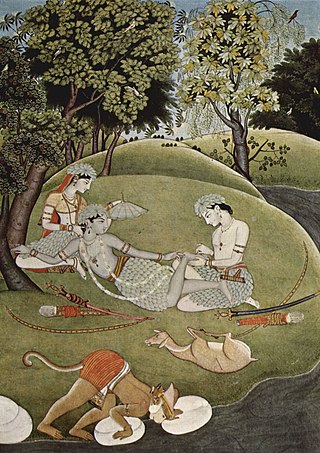
The Rāmāyana is a Sanskrit epic composed over a period of nearly a millennium, with scholars' estimates for the earliest stage of the text ranging from the 8th to 4th centuries BCE, and later stages extending up to the 3rd century CE. Ramayana is one of the two important epics of Hinduism, the other being the Mahābhārata.

Ravana is a rakshasa king of the island of Lanka, and the chief antagonist of the Hindu epic Ramayana and its adaptations. In the Ramayana, Ravana is described to be the eldest son of sage Vishrava and rakshasi Kaikesi. He abducted Prince Rama's wife Sita and took her to his kingdom of Lanka, where he held her in the Ashoka Vatika. Later, Rama, with the support of vanara King Sugriva and his army of vanaras, launched an invasion against Ravana in Lanka. Ravana was subsequently slain and Rama rescued his beloved wife Sita.
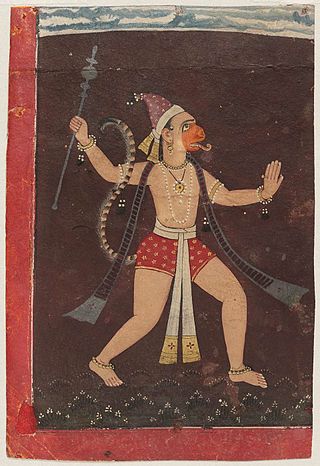
Hanuman, also called Anjaneya, is a Hindu god and a divine vanara companion of the god Rama. Hanuman is one of the central characters of the Hindu epic Ramayana. He is an ardent devotee of Rama and one of the Chiranjivis. Hanuman is regarded to be the son of the wind-god Vayu, who in several stories played a direct role in Hanuman's birth, and considered to be an incarnation or son of Shiva in Shaivism. Hanuman is mentioned in several other texts, such as the epic Mahabharata and the various Puranas.
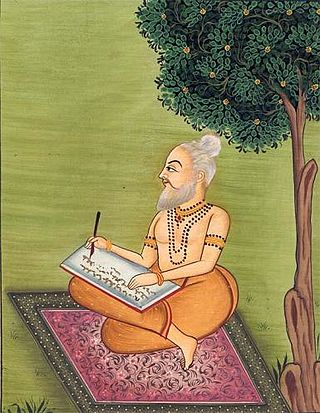
Valmiki is celebrated as the harbinger-poet in Sanskrit literature. The epic Ramayana, dated variously from the 5th century BCE to first century BCE, is attributed to him, based on the attribution in the text itself. He is revered as Ādi Kavi, the first poet, author of Ramayana, the first epic poem.

In the Hindu epic Ramayana, Maricha, or Mareecha is a demon, who was killed by Rama, the hero of the epic and an avatar of Lord Vishnu. He is mentioned as an ally of Ravana, the antagonist of the epic. His most notable exploit is his role in the kidnapping of Sita, Rama's wife. His son Kalanemi was killed by Hanuman.

In Hindu, Vanara are either monkeys, apes, or a race of forest-dwelling people.

Vibhishana is the younger brother of Ravana, the King of Lanka, in the ancient Indian epic Ramayana. Though a rakshasa himself, Vibhishana turned his back on Ravana, and defected to Rama's side, owing to his dharma. After Rama defeated Ravana, the former crowned Prince Vibhishana as the King of Lanka before returning to Ayodhya.

Kumbhakarna is a powerful rakshasa and younger brother of Ravana from the Hindu epic Ramayana. Despite his gigantic size and appetite, he is described as a virtuous character and a great warrior in Hindu texts. He is said to have slaughtered 8,000 vanaras over the course of Rama's invasion of Lanka.

Shiva Tandava Stotra is a Sanskrit stotra (hymn) that is dedicated to the Hindu deity, Shiva. Its authorship is traditionally attributed to Ravana, the King of Lanka, who is considered to be a great devotee of Shiva, composed during his plea for moksha.

Rambha is one of the prominent apsaras, the celestial nymphs of Svarga, in Hindu mythology. She is extolled to be unrivalled in her accomplishments in the arts of dancing, music, and beauty.

Adhyatma Ramayana is a 13th- to 15th-century Sanskrit text that allegorically interprets the story of Hindu epic Ramayana in the Advaita Vedanta framework. It is embedded in the latter portion of Brahmānda Purana, and the author is considered to be Veda Vyasa. The Hindu tradition also attributes the text to the Bhakti movement saint Ramananda.

Sarala Dasa was a 15th-century poet and scholar of Odia literature. Best known for three Odia books — Mahabharata, Vilanka Ramayana and Chandi Purana — he was the first scholar to write in Odia and his revered as the Adi Kabi of Odia literature. As an originator of Odia literature, his work has formed an enduring source of information for succeeding generations.

Malyavan is a character in Hindu mythology, appearing in the epic Ramayana. A rakshasa, he is the son of Sukesha, and the brother of Mālī and Sumālī. He is described to be a major counsellor to the King of Lanka, Ravana, along with also being the latter's maternal grandfather.
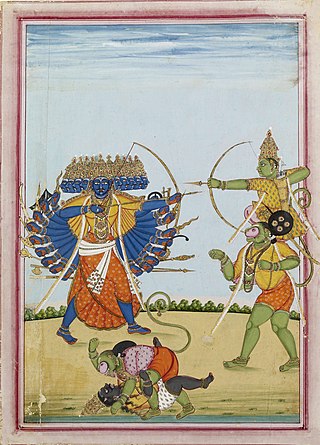
Depending on the methods of counting, as many as three hundred versions of the Indian Hindu epic poem, the Ramayana, are known to exist. The oldest version is generally recognized to be the Sanskrit version attributed to the sage Narada, the Mula Ramayana. Narada passed on the knowledge to Valmiki, who authored Valmiki Ramayana, the present oldest available version of Ramayana.
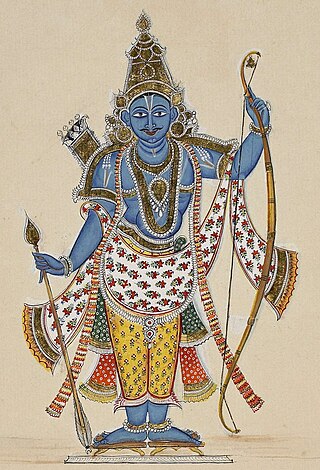
Rama, Ram, Raman or Ramar, also known as Ramachandra, is a major deity in Hinduism. He is the seventh and one of the most popular avatars of Vishnu. In Rama-centric traditions of Hinduism, he is considered the Supreme Being.

Panchakanya is a group of five iconic women of the Hindu epics, extolled in a hymn and whose names are believed to dispel sin when recited. They are Ahalya, Draupadi, Kunti, Tara, and Mandodari. While Draupadi and Kunti are from Mahabharata, Ahalya, Tara and Mandodari are from the epic Ramayana.

Trijata is a rakshasi (demoness) in the Hindu epic Ramayana who is assigned the duty of guarding Sita who was kidnapped by the king of Lanka Ravana. In latter adaptions of Ramayana, Trijata is described as a daughter of Vibhishana, the brother of Ravana.
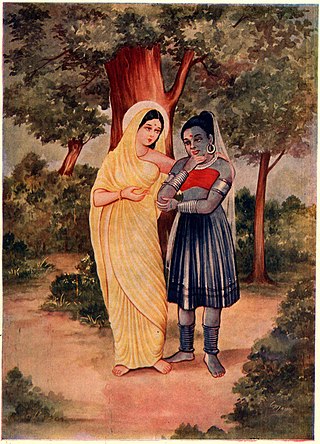
In the Hindu epic Ramayana, Sarama is the wife of Vibhishana, the brother of Ravana, the demon (rakshasa) king of Lanka. Sometimes, she is described a rakshasi (demoness), at other times, she is said to have gandharva lineage. All accounts agree that Sarama was friendly to Sita, the consort of Rama, who was kidnapped by Ravana and imprisoned in Lanka. Like her husband who sides with Rama in the war against Ravana, Sarama is kind to Sita and aids Rama. Sarama and Vibhishana had a daughter called Trijata.
Nagachandra or Abhinava Pampa was a 12th-century poet in the Kannada language.
Jagamohana Ramayana also known as Dandi Ramayana popularly across Odisha is an epic poem composed by the 15th-century poet Balarama Dasa. This work is a retelling of the Ramayana though not a direct translation.
References
- ↑ Bose, Mandakranta (30 September 2004). The Ramayana Revisited. Oxford University Press. p. 96. ISBN 978-0-19-516832-7 . Retrieved 26 September 2022.
- ↑ Senapati, Rabindra Mohan (2004). Art and Culture of Orissa. Publications Division Ministry of Information & Broadcasting. ISBN 9789354095351 . Retrieved 26 September 2022.
- ↑ Panda, Basanta Kumar (January 2016). "Mirror of the Myth" (PDF). Odisha Review.
- ↑ Sukhdeva (2002). Living Thoughts of the Ramayana. Jaico Publishing House. p. 7. ISBN 978-81-7992-002-2.
- ↑ Sujit Mukherjee (1998). A Dictionary of Indian Literature: Beginnings-1850. Orient Blackswan. p. 420. ISBN 978-81-250-1453-9.
- ↑ G. C. Praharaj (1931). Purnachandra Oriya Bhasha Kosh, Volume-V. Utkal Sahitya Press. p. 572.
